While the strongest gusts had happened that night, it remained quite windy for the next three days. There wasn't much off-camp activity, so most of the time was spend with lectures.
Well, that sounds much too stuffy and formal. What happened was more like 'people talking about stuff they like'. I've got this little pet theory of mine that even the dullest topics can be interesting, if someone, who is enthusiastic about it, talks about it. I, for example, can't get at all excited about dog shows and competitions. And if I find myself in one of those, I'd be bored after five minutes and leave. But I can sit attentively for an hour or two and listen to someone who breeds dogs and talks about it. (I know that from experience...) [Ok, an important factor seems to be that the talker knows that he talks to an audience who has no idea about the topic. Otherwise it turns into a discussion among experts and the rest has no idea what's going on and gets bored.]
As a specific example, I have no interest in knots whatsoever. About as boring as embroidery, as far as I am concerned. But Andy, one of the guides, gave a presentation about knots and crevasse rescue, and it was utterly fascinating. It didn't start from 'there is this knot and there is that knot and there are the following basic kinds of knots', but it started from a practical point of view. "I got a rope and I need to tie it to my belt or harness. What kind of knot do I need?" "I've fallen into a crevasse and need to climb up the rope, but haven't got any grip. What features does a knot need here?" Andy was clearly interested in and knowledgeable about knots from a practical point of view (knots aren't a hobby for him, they're tools of the trade) and it was an interesting lecture about a subject I never cared about.
Of course, it helped that most people at Patriot Hills had done quite interesting things in the past. So the doctor gave a talk about providing medical support for the Everest marathon. (No, they don't run up Mt.Everest, they start a bit below base camp and run downwards for most of the race - which sounds is still a very tough challenge.) Or Ian, one of the geologists talked about the challenge to measure continental drift in Antarctica. It's trickier than expected, since you can't just put automated GPS stations somewhere and leave them there. They won't make it through the winter. (While solar panels are ok for the summer, they are useless in the winter. And, as someone else had said, attempts to provide electricity by wind wheels have turned into grants for littering Antarctica with windmill parts.) So the GPS receivers have to be put somewhere in the beginning of the season and collected before the end of the season, which severely limits their number and the amount of available data.
And Bob, the other NSF geologist talked about science at the South Pole and about continental drift and 'hotspots'. And so on. Quite a wide range of topics by people who were enthusiastic about them. (Which seems to be a given down there. Nobody works in the Antarctic because they couldn't find anything else. So everybody there has something that fascinates them. Which, fortunately, invalidates the old saying about working in Antarctica: "The first year, you come for the adventure. The second year, you come for the money. The third year, you come because you no longer fit in anywhere else." Which makes it sound as if only weirdoes and social outcasts work in Antarctica. I got the impression that everyone there would easily fit somewhere else. And, in fact, they have to. Summer season is short in Antarctica, so even those people who spend a lot of summers there, will need to find a job for the rest of the year. And they probably have no problem doing this. Especially since there are a lot of personalities working down there, but no egos. Clients may have egos, but if you work in a very small community with nowhere to go, you are going to have to be able to be calm about things and fit in, instead of throwing your ego around or sulk.)
That got a bit off-topic there. Back to the vacation.
After we were back from the South Pole, it seemed like the trip was essentially over for some in the group. The goal had been achieved and the main question was "When will the wind subside and when can we get back." People spent more time in their tents, just came out for lunch and lectures and planned for the time ahead. For me, the opposite happened. The South Pole trip, which I had thought, hoped and worried about for so long, had happened and it was a wonderful experience and nothing was going to change that. So now I no longer had to worry about that and could enjoy my stay in Patriot Hills.
Also, windy days and snow blowing over the ground were fun. I spend a lot of time outside and looked at the landscape for a while. Similar things happened at night. I got up at 1 am, needing to go to the loo, went there, and on the way back thought "this just looks too amazing - I can't sleep through this", wrapped up warmly in my gear and stared at the snowdrift over the hills for an hour before going back to sleep. I was utterly fascinated by the place.
How can you not love a place like this?

The temperature didn't change much at all during the time in Patriot Hills; it wasn't any colder than at New Year's Eve, when I had been walking around in a t-shirt. I wouldn't have dared to do that on a day with wind like this. (Well, not for any significant amount of time. For rushing over to the main tent from the sleeping tent, it was still ok. The body doesn't cool down that fast.) But when standing outside and looking at the onrushing snow drifts, I was usually dressed like this:


But with that stuff on, it was no problem at all. Not surprisingly, since the gear we had was the same they use for the 'Last Degree' trip. It's designed to keep you comfortably warm at much lower temperatures when you're out for days or weeks and have no warm tent nearby. So while it looks cold and uncomfortable on some of the pictures, I felt very warm and comfortable.
I also took quite a few pictures while I was standing outside. There's not much to say about them. Various views from and of Patriot Hills camp over a period of three days.







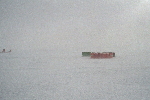





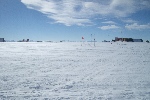


















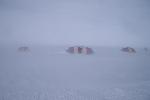





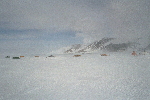

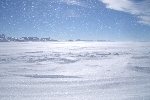


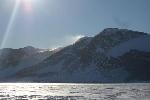







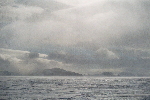




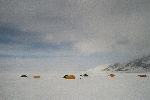

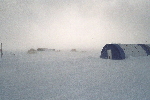





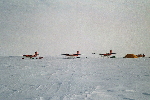

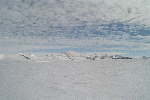


Most of the time, when I was standing outside during the day, I could see Cherry (the photographer) being around and taking pictures,

While there wasn't any real white-out during the time I spent in Antarctica, it got close a couple of times (and it looks like it in a couple of pictures). Basically a white-out is when it gets all cloudy and the light is so diffuse that there aren't any shadows and you can't distinguish any features in the snow. So while visibility as such may be pretty good (so it's not at all like walking in fog - you can easily see tents that are quite some distance away), you can't see the ground right in front of you. So you can easily stumble over patches of snow or uneven terrain or even fall into holes in full daylight.


An odd sight are 'inverse' shoeprints in the snow. When you walk across some freshly blown snow, you compact the snow at the places were you put down your show. When the wind starts blowing again, all the soft snow will be blown away, while the shoeprint remains standing.
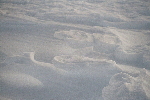
On the third day, weather improved. It was still a bit windy. (It was too windy for the Ilyushin to come in, which everyone but me seemed to regret - I wouldn't have minded if the Ilyushin couldn't have landed for a couple more weeks... The whole thing had a bit of a "Mary Poppins feel" to it now: "I'll be with you until the wind changes, then I'll have to leave you.") But it was calm enough for outside activities. This, for the people working in Patriot Hills, meant taking care of the damage and removing the snow.



Snow was attached to objects in interesting ways.

Life pretty much returned to normal.

Twin Otters flew again.

When the weather improved, outside activities returned to the schedule. One of them was cross-country skiing. We didn't actually go anywhere, but we got a pair of skis each and some basic instruction on how to use them. (This, as far as I recall, went along the lines: "Move your feet forward and don't fall over. There's not much of a trick to it".) Wasn't quite that easy and I was feeling pretty clumsy (and always had the feeling that I would be much faster if I just dropped the skis and walked), but it was a fun thing to do.

It was also very convenient that they had the Marathon track. There was going to be a Marathon right after we left (the runners would come with the Ilyushin that would take us back to Chile), so they prepared a course by driving down the track with the Tucker while pulling a heavy sledge and marking the course with a wooden pole every couple of hundred meters or so. As a side effect of having this nice flattened path, I didn't have to go over uneven terrain with the skis.
Later somebody suggested that, if I was interested, I could get some more practice and that they could provide me with a pair of skis for the remainder of the time in Antarctica. So instead of standing around in the camp and looking at the landscape, I could move around on skis. Down the Marathon track for a bit on one side of the camp and down to the hangar on the other side. Still staying fairly close to the camp, but having something to do. So during the last two days, you could see me moving around on skis during many odd hours. I never really got the hang of it. It was always just shuffling my feet in an awkward manner and it never turned into a smooth motion, except sometimes for two or three steps, when I got an idea of how it was probably supposed to be, but it was fun to have something new to try out.